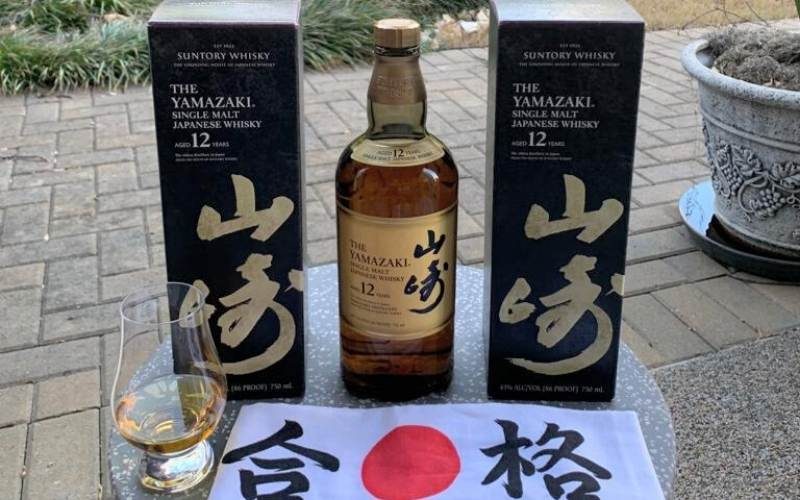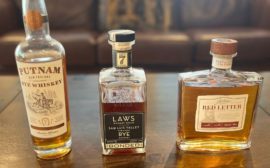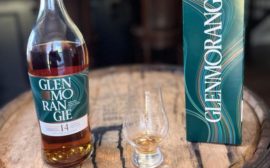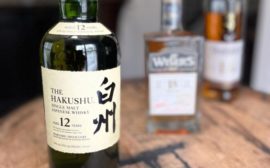Whisky: Yamazaki 12 Year Old Japanese Whisky
Producer: Beam Suntory
Distillery: Yamazaki
Region: Osaka, Japan
Whisky Type: Single Malt (100% malted barley)
Age: 12 years
ABV: 43%
Aged in Cask: ex-bourbon, ex-sherry, and Mizunara Oak
Price Range: $$$$
Suntory Holdings Ltd was founded in 1899 in Osaka by wine merchant Shinjiro Torii, one of the founding fathers of Japanese Whisky.
In 1923, Torii opened his first distillery, Yamazaki, in the Osaka prefecture, a location that provided a few key elements to the business: Easy access to a pure water source to ensure quality whisky, an affordable central location with a railway to allow easy transport and sale to a big market like Tokyo, a vibrant food culture, academic institutions, and a booming economy.
In 1929, Suntory launched the first Japanese whisky, Shirofuda, meaning White Label. Unfortunately, the single malt was too smoky and peaty for the Japanese market, and sales of Shirofuda were anemic.
Perhaps Torri and Taketsuru had different visions. Torii wanted to make a palatable and approachable whisky for the average Japanese, while Taketsuru wanted to showcase the traditional smoky style to honor his teachers in Scotland.
In 1934, Taketsuru resigned and looked north to start a new chapter in his career by founding the Yoichi Distillery in the remote island of Hokkaido, establishing NIKKA (short for Nippon Kaju) as a company and brand for future releases.
Suntory and the changing Japanese market
Suntory has done an incredible job adapting to market changes and consumer preferences by improving and reinventing its products. The rebranding of the Kakubin Japanese Highball is a good example.
The story starts with sales of Japanese Whisky thriving from the 1950s to the early 1980s, peaking in 1983, but experiencing a steady decline a year later triggered by a “healthy” trend that involved the consumption of fruitier, sweeter, low alcohol Shochu drinks popular among younger customers, especially females. The infamous trend in the Japanese alcohol industry is known as the Shochu Shock.
Shochu is a Japanese distilled spirit made with grain or vegetables such as barley, rice, buckwheat, or sweet potatoes.
In 1989, a tax reform lowered taxes on premium whisky, damaging the perception of whisky as a high-end product in the minds of the salaried workers. On top of these market changes, the Yamazaki whisky brand felt outdated and perceived as something your grandfather would drink.
In 1937, Suntory introduced the Kakubin blend, bottled in a distinctive square shape, which became a hit when enjoyed in the form of a highball (1/4 whisky, and 3/4 soda). However, by 1992 the Kakubin brand and the entire whisky category continued to decline in sales and popularity, while draft beer consumption was everyone’s first drink at the bars.
In 2007, Suntory wanted to change all this and decided to rebrand Kakubin whisky by implementing the following:
- Promoted and repositioned the Suntory’s Kakubin Highball to compete with beer, then the drink of choice because it could pair well with food.
- Changed the recipe of the Kakubin highball by adding more gas and lemon as a key ingredient.
- The highball would be served from a highball tower (similar to a beer tap) in every bar, just like a draft beer.
- A new mug design with the Suntory logo conveyed that this highball was not the same as the Kakubin highball from 1937.
- Created a pilot Suntory Izakaya to test the concept and get customer responses, collect enough data, and find the winning recipe.
- Suntory signed more than 300 bars and restaurants to stock the new style of Kakubin Highball.
- Trained the sales staff, bars, and restaurants to ensure the highball recipe contained all ingredients in the correct proportions to achieve a consistent flavor.
- In 2009, Suntory hired model/actress Koyuki, famous for her role in The Last Samurai to launch a marketing campaign on TV and print ads.
- The launch of the Kaku highball keg enabled Suntory to increase the number of highball towers installed in the country.
The Kakubin Highball rebranding campaign produced these results:
- A famous morning TV program aired a segment about the Kakubin Highball giving Suntory free and mass advertisement that changed the “my grandfather’s drink” perception.
- Total sales for 2009 had grown from 3% to 26%.
- Brand awareness had grown from 31% to 78%.
- 60,000 Izakaya restaurants were on board with the Kakubin Highball.
- Sales of Suntory whisky grew from 1.5 million cases to 2 million by the end of 2009 and 3 million cases by the end of 2010.
The Market reacts to Suntory’s success
After the success of the Kakubin Highball, Suntory continued its path to success when Hibiki 21 won the award of best whisky of the world in the World Whisky Awards in 2010. In addition, premium brands such as Yamazaki and Hakushu kept winning international competitions, defeating even the most traditional and respected Scotch Whisky brands.
The hype took another level in 2015 when whisky writer Jim Murray described the Yamazaki 2013 Sherry Cask as “near incredible genius”, giving 97.5 marks out of 100 in his annual whisky guide, The Whisky Bible. For the first time in the guide’s 11-year history, a Japanese whisky had received the prestigious accolade. For this reason, the single malt became an instant collectible, sending its price to the stratosphere in world auctions.
The success of Suntory and its distilleries created a domestic and international frenzy causing a shortage of age statement whiskies from Yamazaki, Hakushu, and Hibiki brands, opening the door to online and traditional auction houses not just for Suntory, but for other Japanese distilleries. The prestige of Suntory and Nikka placed the entire Japanese Whisky industry on the world map, creating a new generation of Japanese Whisky aficionados.
In 2015, Suntory discontinued the iconic Hibiki 12 years old blend and launched Hibiki Japanese Harmony, a non-age statement version made with younger malt and grain whiskies. Fortunately, Yamazaki 12 has never been discontinued, but its price has more than doubled ($$$$) in recent years due to overwhelming demand.
In January 2014, Suntory purchased Beam Inc. for $16 billion, acquiring famous bourbon brands such as Jim Beam and Makers Mark. The deal made Beam Suntory, one of the top producers of alcoholic beverages in the world, behind Diageo and Pernod Ricard.
Tasting Notes for Yamazaki 12 Year Old
Yamazaki 12 was Suntory’s flagship whisky and a point of reference for all other Japanese single malts.
Nose: Sherry, slight bourbon nose and oranges.
Palate: A good balance between sherry, citrus, and a touch of vanilla. A very balanced and lovely dram!
Finish: Medium finish. Wood, spice, and incense flavors linger for a few seconds, but citrus remains in the background.
Awards
Double Gold Medal Award San Francisco World Spirits Competition, 2013.
Gold Award International Spirits Challenge, 2010.
Conclusion: Another great introduction to Japanese single malts. The flagship whisky from the oldest distillery in Japan creates a complex flavor profile that feels beyond 12 years of age. A conscious effort to orchestrate flavors is very evident in this expression. I highly recommend it to those new to Japanese Whisky. Cheers!
Score: 4/5 ⭐
Interested in more Japanese whisky reviews? Check here and you’ll also find more interesting information on Japanese whiskies, such as labeling guidelines and more. On my Instagram account, you’ll find pics and more whisky-related content.
Legend
$50 or less $
$51-$100 $$
$101-$150 $$$
$151 or more $$$$





